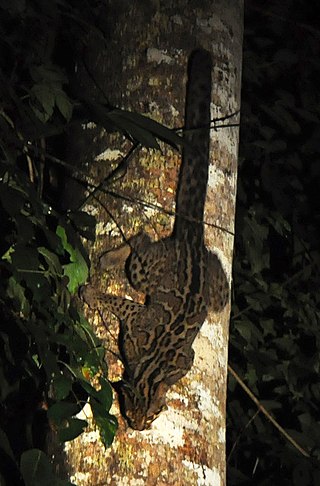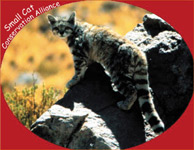
Neofelis is a genus comprising two extant cat species in Southeast Asia: the clouded leopard of mainland Asia, and the Sunda clouded leopard of Sumatra and Borneo.

The bay cat, also known as the Bornean bay cat, is a small wild cat endemic to the island of Borneo that appears to be relatively rare compared to sympatric wild cats, based on the paucity of historical, as well as recent records. Since 2002, it has been listed as Endangered on the IUCN Red List because it is estimated that fewer than 2,500 mature individuals exist, and that the population declined in the past. The bay cat has been recorded as rare and seems to occur at relatively low density, even in pristine habitat.

The leopard cat is a small wild cat native to continental South, Southeast, and East Asia. Since 2002 it has been listed as Least Concern on the IUCN Red List as it is widely distributed although threatened by habitat loss and hunting in parts of its range.

The fishing cat is a medium-sized wild cat of South and Southeast Asia. Since 2016, it is listed as Vulnerable on the IUCN Red List. Fishing cat populations are threatened by destruction of wetlands and have declined severely over the last decade. The fishing cat lives foremost in the vicinity of wetlands, along rivers, streams, oxbow lakes, in swamps, and mangroves.

The flat-headed cat is a small wild cat with short reddish-brown fur. Its head is elongated, and its ears are rounded. Its slender body is 41 to 50 cm long with a tail of 13 to 15 cm, and it weighs 1.5 to 2.5 kg.

Prionailurus is a genus of spotted, small wild cats native to Asia. Forests are their preferred habitat; they feed on small mammals, reptiles and birds, and occasionally aquatic wildlife.

The marbled cat is a small wild cat native from the eastern Himalayas to Southeast Asia, where it inhabits forests up to an elevation of 2,500 m (8,200 ft). As it is present in a large range, it has been listed as Near Threatened on the IUCN Red List since 2015.
The leopard is one of the five "big cats" in the genus Panthera.

The Sunda stink badger, also called the Javan stink badger, teledu, Malay stink badger, Malay badger, Indonesian stink badger and Sunda skunk, is a mammal native to Indonesia and Malaysia. Despite the common name, stink badgers are not closely related to true badgers, and are, instead, Old World relatives of the skunks. Coincidentally, its local name sigung in Sundanese is a false cognate to skunk which is of Algonquian origin.

The Sunda clouded leopard is a medium-sized wild cat native to Borneo and Sumatra. It is listed as Vulnerable on the IUCN Red List since 2015, as the total effective population probably consists of fewer than 10,000 mature individuals, with a decreasing population trend. On both Sunda Islands, it is threatened by deforestation. It was classified as a separate species, distinct from the clouded leopard in mainland Southeast Asia based on a study in 2006. Its fur is darker with a smaller cloud pattern.

The Bornean clouded leopard is a subspecies of the Sunda clouded leopard. It is native to the island of Borneo, and differs from the Batu-Sumatran clouded leopard in the shape and frequency of spots, as well as in cranio-mandibular and dental characters. In 2017, the Cat Classification Taskforce of the Cat Specialist Group recognized the validity of this subspecies.

The lesser coucal is a species of cuckoo in the family Cuculidae. It has a wide distribution range that overlaps with several other similar species. The habitat in which it is found is often marshy land with grass and tree cover. It is distinguished by its smaller size, less prominent bill, pale shaft streaks on the feathers of the head and back. It has a much longer claw on its hind toe and a distinct call. It is also among the few coucals that show season plumage differences but like in other coucals, the sexes cannot be distinguished in the field.

Stink badgers or false badgers are the species of the genus Mydaus of the skunk family of carnivorans, the Mephitidae. They resemble the better-known members of the family Mustelidae also termed 'badgers'. There are only two extant species – the Palawan stink badger or pantot, and the Sunda stink badger or teledu. They live west of the Wallace Line; the Sunda species on islands of the Greater Sunda Islands, being Sumatra, Java, and Borneo; in Borneo the badger is found in Indonesia, Malaysia and Brunei. The Palawan species lives in the Philippine island of Palawan as well as the islands surrounding it.
The Visayan leopard cat, known locally as maral, is a Sunda leopard cat population in the Philippine Islands of Negros, Cebu and Panay. It has been listed as vulnerable on the IUCN Red List in 2008 under its former scientific name P. bengalensis rabori as its range is estimated to be less than 20,000 km2 (7,700 sq mi), and the population was thought to be decreasing.

The Small Cat Conservation Alliance (SCCA) was founded in 1996, to address the conservation needs of small wild cats and their habitat worldwide. Small Cat Conservation Alliance seeks out local scientists and volunteers that are working to protect small cats in remote regions worldwide. They collect data that can be used to seek endangered species classification. SCCA operates in Kalimantan (Borneo), Sumatra, Chile, and China; and works with partners in Argentina, Bolivia, Brazil, Cambodia, India, Sarawak, Suriname and Vietnam. The Small Cat Conservation is also partnered with the Wildlife Conservation Network.

Rhododendron javanicum is a rhododendron species native to Indonesia, Malaysia, and the Philippines. This evergreen shrub grows to 5 m (16 ft) with bright orange flowers in spring. Plants may be terrestrial or epiphytic. Some forms from the Philippines may have red or bicoloured flowers, but are less often seen in cultivation.

The Bornean tiger or Borneo tiger is possibly an extinct tiger population that lived on the island of Borneo in prehistoric times. A live Bornean tiger has not been conclusively recorded, but the indigenous Dayak people believe in its existence, and occasionally report sightings.
Lawrence Richard Heaney is an American mammalogist, ecologist and biogeographer. His research focus is the mammals of the Philippines.















